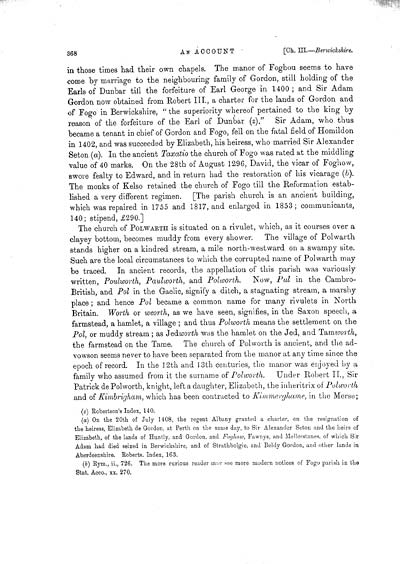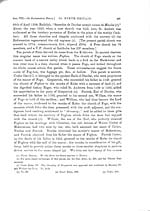Volume 3
(380) Page 368
Download files
Individual page:
Thumbnail gallery: Grid view | List view

368 in those times had their own chapels. The manor of Foghou seems to have come by marriage to the neighbouring family of Gordon, still holding of the Earls of Dunbar till the forfeiture of Earl George in 1400 ; and Sir Adam Gordon now obtained from Robert III., a charter for the lands of Gordon and of Fogo in Berwickshire, " the superiority whereof pertained to the king by reason of the forfeiture of the Earl of Dunbar (z)." Sir Adam, who thus became a tenant in chief of Gordon and Fogo, fell on the fatal field of Homildon in 1402, and was succeeded by Elizabeth, his heiress, who married Sir Alexander Seton (a). In the ancient Taxatio the church of Fogo was rated at the middling value of 40 marks. On the 28th of August 1296, David, the vicar of Foghow, swore fealty to Edward, and in return had the restoration of his vicarage (6). The monks of Kelso retained the church of Fogo till the Reformation estab- lished a very different regimen. [The parish church is an ancient building, which was repaired in 1755 and 1817, and enlarged in 1853; communicants, 140; stipend, �290.] The church of POLWARTH is situated on a rivulet, which, as it courses over a clayey bottom, becomes muddy from every shower. The village of Polwarth stands higher on a kindred stream, a mile north-westward on a swampy site. Such are the local circumstances to which the corrupted name of Polwarth may be traced. In ancient records, the appellation of this parish was variously written, Poulworth, Paulworth, and Polworth. Now, Pul in the Cambro- British, and Pol in the Gaelic, signify a ditch, a stagnating stream, a marshy place; and hence Pol became a common name for many rivulets in North Britain. Worth or weorth, as we have seen, signifies, in the Saxon speech, a farmstead, a hamlet, a village ; and thus Polworth means the settlement on the Pol, or muddy stream ; as Jedworth was the hamlet on the Jed, and Tamworth, the farmstead on the Tame. The church of Polworth is ancient, and the ad- vowson seems never to have been separated from the manor at any time since the epoch of record. In the 12th and 13th centuries, the manor was enjoyed by a family who assumed from it the surname of Polworth. Under Robert II., Sir Patrick de Polworth, knight, left a daughter, Elizabeth, the inheritrix of Polworth and of Kimbrigham, which has been contracted to Kimmerghame, in the Merse; (z) Robertson's Index, 140. (a) On the 20th of July 1408, the regent Albany granted a charter, on the resignation of the heiress, Elizabeth de Gordon, at Perth on the same day, to Sir Alexander Seton and the heirs of Elizabeth, of the lands of Huntly. and Gordon, and Foghow, Fawnys, and Melleratanes, of which Sir Adam had died seized in Berwickshire, and of Strathbolgie, and Beldy Gordon, and other lands in Aberdeenshire. Roberts. Index, 163. (b) Rym., ii., 726. The more curious reader rnay see more modern notices of Fogo parish in the Stat. Acco., xx. 270.
Set display mode to:
![]() Universal Viewer |
Universal Viewer | ![]() Mirador |
Large image | Transcription
Mirador |
Large image | Transcription
Images and transcriptions on this page, including medium image downloads, may be used under the Creative Commons Attribution 4.0 International Licence unless otherwise stated. ![]()
| Caledonia, or, An account, historical and topographic of North Britain from the most ancient to the present times > Volume 3 > (380) Page 368 |
|---|
| Permanent URL | https://digital.nls.uk/74528834 |
|---|---|
| Description | Vol. III. |
|---|---|
| Attribution and copyright: |
|

